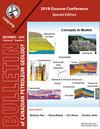加拿大东北艾伯塔省下白垩统McMurray组斜异石器层序的纹层尺度韵律性
Q3 Earth and Planetary Sciences
引用次数: 13
摘要
阿萨巴斯卡油砂以倾斜、互层、层间的砂岩和泥岩岩质体为主要特征的斜斜异质层序是油砂的主要组成部分。河流作用通常被解释为斜异石器层理中岩性变化和伴随旋回的主要原因。本研究的目的是应用定量和视觉频率分析技术,确定和解释斜异石器层状岩质体的层状旋回性。根据不同的工艺和沉积学特征,将皮埃尔河地区的斜异石器层理划分为5个岩质体。对于每个岩石体,连续小波变换应用于测量纹层或层厚度,作为伪时间序列处理,将这些时间序列转换到频域,以确定岩石体层间部分的旋回性。通过将序列分成波谷和波峰之后的周期,也完成了周期中断的视觉识别。分析结果表明,皮埃尔河地区斜异石器层序层间部分保留了与半日合性小潮-春潮周期相一致的旋回模式。即使在生物扰动层间,层间砂岩和泥岩也是潮汐旋回的标志。较厚的砂岩或泥岩层破坏了斜异石器层积的潮汐夹层部分,被解释为反映了河流通量的变化。该研究有助于更好地了解下白垩统McMurray组沉积时期的潮汐状态,以及控制斜异石器时代分层的层状尺度岩性变异性的过程。本文章由计算机程序翻译,如有差异,请以英文原文为准。
Laminae-scale rhythmicity of inclined heterolithic stratification, Lower Cretaceous McMurray Formation, NE Alberta, Canada
Abstract Inclined Heterolithic Stratification, characterized by dipping, interbedded and interlaminated sandstone and mudstone lithosomes comprises a major portion of the Athabasca Oil Sands. Fluvial processes have generally been interpreted to be the major cause of lithological variations and accompanying cyclicity in Inclined Heterolithic Stratification. The objectives of this research are applying quantitative and visual frequency analysis techniques, to determine and interpret the laminae-scale cyclicity of Inclined Heterolithic Stratification lithosomes. The Inclined Heterolithic Stratification in the Pierre River area is subdivided into five lithosomes based on distinct ichnological and sedimentological features. For each lithosome, Continuous Wavelet Transforms, applied to measurements of laminae or bed thicknesses, treated as pseudo time-series, converts these time-series to the frequency domain in order to determine the cyclicity of interlaminated portions of lithosomes. Visual identification of cycle breaks, by splitting series into cycles following troughs and peaks is completed as well. The results from the analysis demonstrate that the interlaminated portions of Inclined Heterolithic Stratification in the Pierre River Area preserve cyclic patterns that are consistent with semidiurnal synodic neap-spring tidal periodicity. Even in bioturbated intervals, interlaminated sandstone and mudstone is indicative of tidal cyclicity. The thicker sandstone or mudstone beds disrupting the tidally interlaminated portions of Inclined Heterolithic Stratification are interpreted to reflect variations in fluvial flux. This study gives a better understanding of the tidal regime during the lower Cretaceous McMurray Formation deposition and of the processes governing Inclined Heterolithic Stratification laminae-scale lithological variability.
求助全文
通过发布文献求助,成功后即可免费获取论文全文。
去求助
来源期刊

Bullentin of Canadian Petroleum Geology
Earth and Planetary Sciences-Geochemistry and Petrology
CiteScore
2.50
自引率
0.00%
发文量
0
期刊介绍:
The Bulletin of Canadian Petroleum Geology is a peer-reviewed scientific journal published four times a year. Founded in 1953, the BCPG aims to be the journal of record for papers dealing with all aspects of petroleum geology, broadly conceived, with a particularly (though not exclusively) Canadian focus. International submissions are encouraged, especially where a connection can be made to Canadian examples.
 求助内容:
求助内容: 应助结果提醒方式:
应助结果提醒方式:


